
Pietro Lorenzetti or Pietro Laurati was an Italian painter, active between c. 1306 and 1345. Together with his younger brother Ambrogio, he introduced naturalism into Sienese art. In their artistry and experiments with three-dimensional and spatial arrangements, the brothers foreshadowed the art of the Renaissance.

Domenico di Michelino (1417–1491) was an Italian Renaissance painter who was born and died in Florence. His real name was Domenico di Francesco. The patronymic "di Michelino" was adopted in honor of his teacher, the cassone painter Michelino di Benedetto, by whom no works have been identified. Giorgio Vasari reports that Domenico was also a pupil of Fra Angelico, whose influence is reflected in many of Domenico's paintings along with that of Filippo Lippi and Pesellino.

BartolomeoMontagna was an Italian Renaissance painter who mainly worked in Vicenza. He also produced works in Venice, Verona, and Padua. He is most famous for his many Madonnas and his works are known for their soft figures and depiction of eccentric marble architecture. He is considered to be heavily influenced by Giovanni Bellini, in whose workshop he might have worked around 1470. Benedetto Montagna, a productive engraver, was his son and pupil and active until about 1540. He was mentioned in Vasari's Lives as a student of Andrea Mantegna but this is widely contested by art historians.

The Mérode Altarpiece is an oil on oak panel triptych, now in The Cloisters, in New York City. It is unsigned and undated, but attributed to Early Netherlandish painter Robert Campin and an assistant. The three panels represent, from left to right, the donors kneeling in prayer in a garden, the moment of the Annunciation to Mary, which is set in a contemporary, domestic setting, and Saint Joseph, a carpenter with the tools of his trade. The many elements of religious symbolism include the lily and fountain, and the Holy Spirit represented by the rays of light coming through from the central panel's left hand window.

Vincenzo Foppa was an Italian painter from the Renaissance period. While few of his works survive, he was an esteemed and influential painter during his time and is considered the preeminent leader of the Early Lombard School. He spent his career working for the Sforza family, Dukes of Milan, in Pavia, as well as various other patrons throughout Lombardy and Liguria. He lived and worked in his native Brescia during his later years.
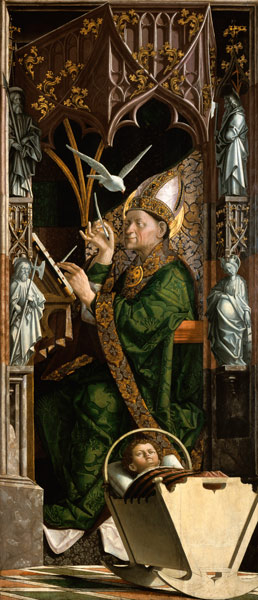
Michael Pacher was a painter and sculptor from Tyrol active during the second half of the fifteenth century. He was one of the earliest artists to introduce the principles of Renaissance painting into Germany. Pacher was a comprehensive artist with a broad range of sculpting, painting, and architecture skills producing works of complex wood and stone. He painted structures for altarpieces on a scale unparalleled in North European art.

The Doni Tondo or Doni Madonna, is the only finished panel painting by the mature Michelangelo to survive. Now in the Uffizi in Florence, Italy, and still in its original frame, the Doni Tondo was probably commissioned by Agnolo Doni to commemorate his marriage to Maddalena Strozzi, the daughter of a powerful Tuscan family. The painting is in the form of a tondo, meaning in Italian, 'round', a shape which is frequently associated during the Renaissance with domestic ideas.

Jacobello del Fiore was a Venetian painter in the late fourteenth century and early fifteenth century. His early work is in the Late Gothic style popularized by Altichiero da Verona and Jacopo Avanzi, two of his contemporaries, while his mature work displays a local Venetian style established by the school of Paolo Veneziano, an artist and workshop proprietor with notable Byzantine inspiration in his work. This stylistic return to his roots sets him apart from Niccolò di Pietro and Zanino di Pietro, Venetian contemporaries he is often associated with. During his lifetime, he received commissions primarily on the Adriatic coast and in Venice.
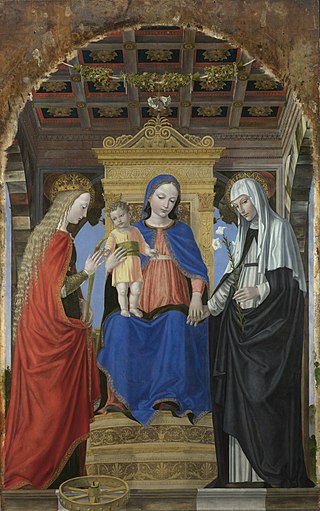
The mystical marriage of Saint Catherine covers two different subjects in Christian art arising from visions received by either Catherine of Alexandria or Catherine of Siena (1347–1380), in which these virgin saints went through a mystical marriage wedding ceremony with Christ, in the presence of the Virgin Mary, consecrating themselves and their virginity to him.
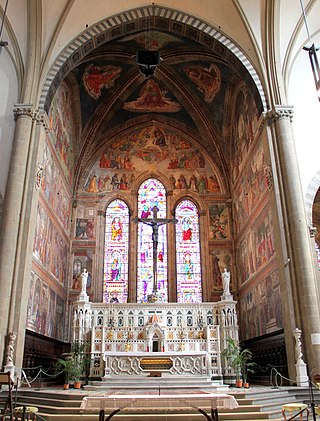
The Tornabuoni Chapel is the main chapel in the church of Santa Maria Novella, Florence, Italy. It is famous for the extensive and well-preserved fresco cycle on its walls, one of the most complete in the city, which was created by Domenico Ghirlandaio and his workshop between 1485 and 1490.

The Nativity of Jesus has been a major subject of Christian art since the 4th century.

The Marriage of the Virgin is the subject in Christian art depicting the marriage of the Virgin Mary and Saint Joseph. The wedding ceremony is not mentioned in the canonical Gospels but is covered in several apocryphal sources and in later redactions, notably the 14th-century compilation the Golden Legend. Unlike many other scenes in Life of the Virgin cycles, it is not a feast in the church calendar, though it sometimes has been in the past.

Michelino Molinari da Besozzo was a notable fifteenth century Italian painter and illuminator, who was widely praised for his work. He worked mostly in Milan and Lombardy, and was employed by the Visconti family, rulers of Milan. Michelino's work follows the traditions of the Lombard School, and maintains the Trecento style.
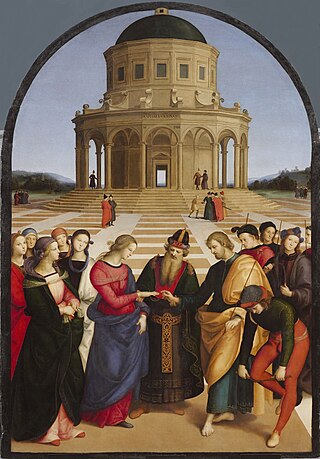
The Marriage of the Virgin, also known as Lo Sposalizio, is an oil painting by the Italian High Renaissance artist Raphael. Completed in 1504 for the Franciscan church of San Francesco, Città di Castello, the painting depicts a marriage ceremony between Mary and Joseph. It changed hands several times before settling in 1806 at the Pinacoteca di Brera.

The Pinacoteca Nazionale is a national museum in Siena, Tuscany, Italy. Inaugurated in 1932, it houses especially late medieval and Renaissance paintings from Italian artists. It is housed in the Brigidi and Buonsignori palaces in the city's center: the former, built in the 14th century, it is traditionally identified as the Pannocchieschi family's residence. The Palazzo Bichi-Buonsignori, although built in the 15th century, has a 19th-century neo-medieval façade based on the city's Palazzo Pubblico.

The Nursing Madonna, Virgo Lactans, or Madonna Lactans, is an iconography of the Madonna and Child in which the Virgin Mary is shown breastfeeding the infant Jesus. In Italian it is called the Madonna del Latte. It was a common type in painting until the change in atmosphere after the Council of Trent, in which it was rather discouraged by the church, at least in public contexts, on grounds of propriety.
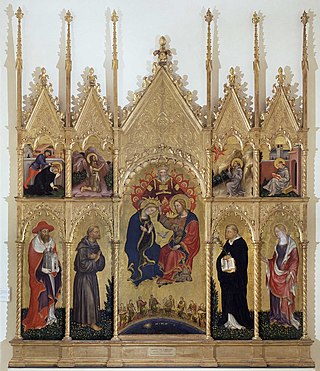
The Valle Romita Polyptych is a painting by the Italian late Gothic painter Gentile da Fabriano, dating from c. 1410-1412 and now housed in the Pinacoteca di Brera in Milan. It was originally executed for the Franciscan hermitage of Valle Romita near Gentile's birthplace, Fabriano.

The Mystical Marriage of Saint Catherine is a painting by the medieval Italian painter Michelino da Besozzo. The painting dates from c. 1420 and is housed in the Pinacoteca Nazionale of Siena, Italy.

The Mystic Marriage of St. Catherine is a c. 1480 oil-on-oak painting by the Early Netherlandish painter Hans Memling, now in the Metropolitan Museum of Art, New York. The panel shows an enthroned Virgin holding the Child. St Catherine of Alexandria and St Barbara are seated alongside. Angels playing instruments flank the throne, while the male figure to left is presumably the person who commissioned it as a devotional donor portrait.

The Marriage of the Virgin or also known as TheBetrothal of the Virgin, is a c. 1420–1430 oil on oak painting by Robert Campin. The painting was intended to be a metaphor, primarily focused on the transition from the Old to the New Testament, which is expressed through iconography and disguised symbolism. It entered into the Spanish royal collection at El Escorial in 1584. It was later obtained by Prado Museum, where it continues to reside. This work by Robert Campin is one of his earliest and was previously attributed to Roger Van der Weyden.




















